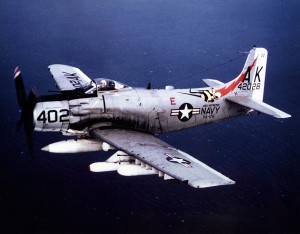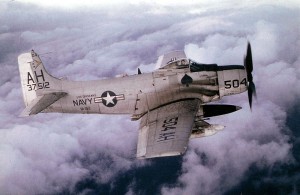Today, in 1945, the XBT2D-1 flew for the first time. It was another of the great designs by Ed Heinemann, the designer of many aircraft produced by the Douglas Aircraft Company. As with many of the aircraft Heinemann created, the Douglas XBT2D-1 was one that would serve the nation for a fairly long time.
Douglas created this airplane as a replacement for other carrier-borne aircraft such as the Helldiver and TBM Avenger. In the end, the airplane served its mission well for both the Navy and the Air Force. Although designed in the mid 1940s, the single-engine bomber would go on to serve the military well through both the Korean and Vietnam wars.
Powered by a Wright R-3350 of 2700 horsepower, the airplane was a lifting animal. She had an empty weight of just under 12,000 pounds, could carry a weapons load of 8000 pounds, and then enough gas to bring the gross weight up to 25,000 pounds in internal fuel tanks, 300-gallon drop tanks underneath each wing, and a 2000 gallon shaped tank on the centerline station. This would keep the AD’s in the air for an extraordinarily long time. Typically about 11 or 12 hours at a time.
Many a Navy pilot would launch from the deck of a carrier on a “sand blower” route. They would be the first airplane launched on a strike, and head off at fuel flows of “max conserve” just above the waves. After going “feet dry” over the badlands, they pushed their throttles up for more speed. Then they struck their targets, egressed as fast as their R-3350s would carry them back to the beach, and once they were feet wet, the pilots throttled back to max conserve again. The Spad pilots would find their way back to the carrier, landing after another four or five hours of flying to get back to the boat. Often they would were the last airplane trapped from the strike, on which they were the first plane launched.
The Spad pilots were a different lot. They were the cream of the crop when it came to providing air support for the ground troops and the rescue helicopters heading in to retrieve downed aviators. They were pilots by the likes of men like Bernie Fisher, a major at the time, who won the Congressional Medal of Honor for landing his A-1E on a battled damaged field to rescue another pilot shot down and trying to avoid capture.
Douglas produced almost 3200 aircraft for the military. The airplane was a part of the inventory from the mid 1940s until into the 1970s. The pilots and maintainers who workedon the airplane either loved her or hated her, but she was as solid and dependable as a rock.
One thing was certain–the soldiers and marines who called the airplane in for closer air support could always depend on the airplane and their pilots.
-30-
© 2011 J. Clark




Your writing gives airplanes living souls and personalities.
Carl, thank you for the magnificent compliment. I hope I can continue to live up to it in the future.
Joe
You have great stories and pix’s I really enjoy them. I point I need to make, Carriers are “SHIPS” not “BOATS”! Boats have oars and Land lobbers use them. From a old Swabby, USN 1950-1954.
Robert,
Glad to meet you, shipmate.
Now, I have to explain, I know they are “ships.” I am an Airedale though (1981-1990) and all us irreverent “brown shoes” call ships “boats” just to irritate (and have fun with) the black shoes…
Thank you for the compliments and I hope you enjoy my other memories from the Navy days.
Joe
Pingback: Able Dogs and Spads (via ) « Calgary Recreational and Ultralight Flying Club
Pingback: Able Dogs and Spads (via ) « Calgary Recreational and Ultralight Flying Club (CRUFC)